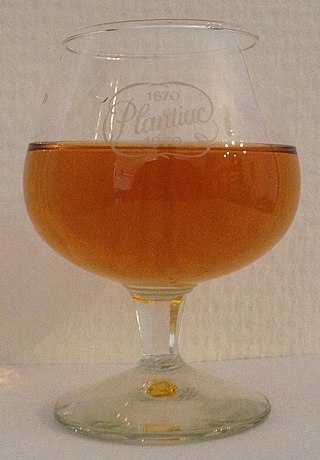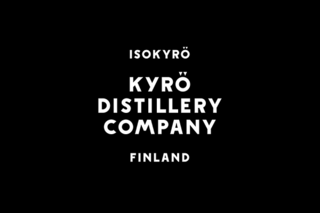This article needs additional citations for verification .(January 2019) |

Tip van Bootz (Tip from Bootz) was an orange-flavoured and orange-coloured Dutch liqueur made by H. Bootz' Distilleerderij N.V. (Amsterdam). [1]
This article needs additional citations for verification .(January 2019) |

Tip van Bootz (Tip from Bootz) was an orange-flavoured and orange-coloured Dutch liqueur made by H. Bootz' Distilleerderij N.V. (Amsterdam). [1]
Tip van Bootz was launched by the Bootz distilling company in 1931 to compensate for the declining sales of its top product Orangeade Triple Sec. With the purchasing power of Dutch consumers gradually decreasing, Bootz needed an affordable product to get through the economic crisis of the 1930s. What distinguished Tip van Bootz from other cheap spirits and liqueurs was that it had a brand name and a distinctive bottle. This white glass bottle was flat and rectangular shaped with slightly rounded corners and a graceful collar between the body and the neck. Furthermore, the Bootz distillery did not shy away from advertising. The introduction campaign centered on the meaning of the brand name and the brand label, that showed an image of the Amsterdam Stock Exchange building (the famous Beurs van Berlage). The advertisement text ran: "A tip after trading hours is only worth something if it is a Tip from Bootz."
From January 1937 to January 1961 – with an interruption from December 1944 to June 1947 – Tip van Bootz was advertised in a very remarkable way. Consumers could send in limericks to the Bootz distillery. Weekly or biweekly, the best limericks were published in small front-page newspaper ads, provided of course that they would mention the brand name Tip van Bootz. The result of this long-running advertising campaign was that Dutch people during the mid 20th century strongly associated limericks, as a form of verse, with the brand Tip van Bootz. [2] Due to its orange colour Tip van Bootz was a huge success in the first post-war years, when Dutch consumers embraced anything that reminded them of the reinstated royal House of Orange-Nassau.
In January 1955 the Bootz distillery was taken over by the much larger Bols distilling company (N.V. Amsterdamse Likeurstokerij ’t Lootsje der Erven Lucas Bols). Bols wisely decided to retain the distinctive Tip van Bootz bottle. The limerick campaign however was discontinued in order to rejuvenate the brand image.
As postwar prosperity in the Netherlands grew, consumer preferences changed from lower to higher-quality types of spirits. Especially male consumers found fruit-flavoured brandies such as Tip van Bootz too sweet. They preferred stronger drinks with a less conspicuous colour. By the mid-1960s, Tip van Bootz had the reputation of being a women's drink. Bols responded by emphasizing that Tip van Bootz could also be used in cocktails and long drinks. To charm male consumers, an advertising figure was created called Tipje van Bootz (1965). This attractive young girl featured in a series of comic strips made by Jan Kruis, as well as in a 1969 television commercial. In 1972, Bols commissioned a song about Tipje, which was released on a 7-inch 45 rpm record. [3] [4] The content of this Carnival song was so sexually insinuating that Tipjes reputation – and by extension the brand image of Tip van Bootz – was seriously damaged.
In the mid-1970s, Bols stopped trying to revitalize the brand. Somewhere in the 1980s, the brand was quietly withdrawn from the market. In 1995 the brand was given a final chance by Bols. This reintroduction proved unsuccessful. Tip van Bootz is now a dead brand that only lives on in the memory of some bottle and label collectors.

Canadian whisky is a type of whisky produced in Canada. Most Canadian whiskies are blended multi-grain liquors containing a large percentage of corn spirits, and are typically lighter and smoother than other whisky styles. When Canadian distillers began adding small amounts of highly-flavourful rye grain to their mashes, people began demanding this new rye-flavoured whisky, referring to it simply as "rye". Today, as for the past two centuries, the terms "rye whisky" and "Canadian whisky" are used interchangeably in Canada and refer to exactly the same product, which generally is made with only a small amount of rye grain.

Gin is a distilled alcoholic drink that derives its flavour from juniper berries and other botanical ingredients.

Akvavit or aquavit is a distilled spirit that is principally produced in Scandinavia, where it has been produced since the 15th century. Akvavit is distilled from grain or potatoes, and is flavoured with a variety of herbs. It is also popular in Northern Germany.

Triple sec is an orange-flavoured liqueur that originated in France. It usually contains 20–40% alcohol by volume.

Jenever, also known as Hollands, genever, genièvre, peket, or sometimes as Dutch gin, is the juniper-flavoured traditional liquor in the Netherlands, Belgium and adjoining areas in northern France and northwestern Germany. As an EU and UK Protected Designation of Origin the use of the term jenever and its soundalikes can only be used if the product is made according to the specifications in Belgium, the Netherlands, two northern French departments and two German federal states. Gin was developed in Britain after introduction of jenever to the island.

KetelOne is a liquor brand of the Nolet Distillery in Schiedam, Netherlands. Ketel One Vodka is distilled from 100% wheat in copper pot stills, filtered over loose charcoal, and rests in tile-lined tanks until ready. Ketel One Vodka is named after the original copper pot still, "Distilleerketel #1." The alcohol content of this spirit is 40%. The Nolet Distillery also makes Ketel One Citroen, Ketel One Oranje, Ketel One Botanical and Ketel 1 Jenever.
Curaçao is a liqueur flavored with the dried peel of the bitter orange laraha, a citrus fruit grown on the Dutch island of Curaçao.
Gordon's is a brand of London dry gin first produced in 1769. The top markets for Gordon's are the United Kingdom, the United States and Greece. It is owned by the British spirits company Diageo. It is the world's best-selling London dry gin. Gordon's has been the UK's number one gin since the late 19th century. A 40% ABV version for the North American market is distilled in Canada.

Kümmel, kummel or kimmel, is a sweet, colourless liqueur flavoured with caraway seeds, cumin and fennel.

Beefeater Gin is a brand of gin owned by Pernod Ricard and bottled and distributed in the United Kingdom. Beefeater remained in the control of its founding Burrough family until 1987. It is a 47% or 44% alcohol product in the US, and a 40% alcohol product elsewhere in the world. The Beefeater distillery is one of 24 in London.
The Polmos Łańcut distillery is one of the oldest producers of liquors and liqueurs in Poland. A small amount of the distillery's output is exported to Belgium, the Netherlands, France, Great Britain, Germany, Italy, and the United States.
DeKuyper Royal Distillers is a privately held Dutch company in the business of manufacturing and marketing distilled spirits and liqueurs.

Korn, also known as Kornbrand or Kornbranntwein, is a German colorless distilled beverage produced from fermented cereal grain seed. The production of Korn uses only five grains: most of the production is based on rye or wheat; barley is mainly used to obtain the required malt for the brewing process; oats and buckwheat are rarely used. The addition of food colorings, flavorings, or sweeteners is not permitted. Korn is distilled to lower alcoholic proofs and less rigorously filtered than vodka, which leaves more of the cereal grain flavor in the finished spirit.
Lucas Bols N.V. is a Dutch public company in the business of production, distribution, sales and marketing of alcoholic beverages. It claims to be the oldest distillery brand in the world. Its brand portfolio consists of Bols, Galliano, Vaccari, Pisang Ambon, Gold Strike and a large group of Dutch genevers and liqueurs. It produces about 3 million cases a year, with yearly revenues exceeding 95 million euros.

Whitley Neill Gin is a London Dry gin.
Distilleries in Canada are distillers of various alcoholic distilled beverages (spirits) such as whisky, rum, vodka, brandy, gin, etc. in the country of Canada.

Sazerac Company, Inc. is a privately held American alcoholic beverage company headquartered in Metairie in the metropolitan area of New Orleans, Louisiana, but with its principal office in Louisville, Kentucky. The company is owned by billionaire William Goldring and his family. As of 2017, it operated nine distilleries, had 2,000 employees, and operated in 112 countries. It is one of the two largest spirits companies in the United States, with annual revenue of about $1 billion made from selling about 300 mostly discount brands.

Dutch brandy is a distilled spirit made from either grain or molasses alcohol flavored with various essences and extracts produced in the Netherlands. It was formerly referred to as "Dutch cognac" until that name was legally restricted to grape brandy from the Cognac region of France. Dutch names included "Koetsiertje" or "Koetsierscognac" or "Hollandse Cognac". Its colour ranges from clear to dark brown, reflecting added caramel or artificial dye.

Soplica is one of the older brands of Polish pure and flavoured vodka, having been first produced in 1891. Although the origins of vodka in Poland can be traced back to as early as the 8th century, Soplica is one of the older industrially produced brands of vodka in the country. Żubrówka, for example, is based on a much older recipe than Soplica but exists as an industrially produced brand only since the 1920s.

Kyrö Distillery Company is a Finnish rye distillery founded in a sauna in 2012. Kyrö uses 100 percent Finnish rye to produce rye gin and rye whisky. In 2015, Kyrö Napue Gin, formerly known as Napue, won the Best Gin for Gin & Tonic category in the International Wine and Spirit competition. In August 2020 Kyrö launched its rye whisky, Kyrö Malt. To support health care workers during COVID-19, Kyrö started producing hand sanitizer. Through the sales of hand sanitizer, the company managed to avoid layoffs, and they have continued in production.